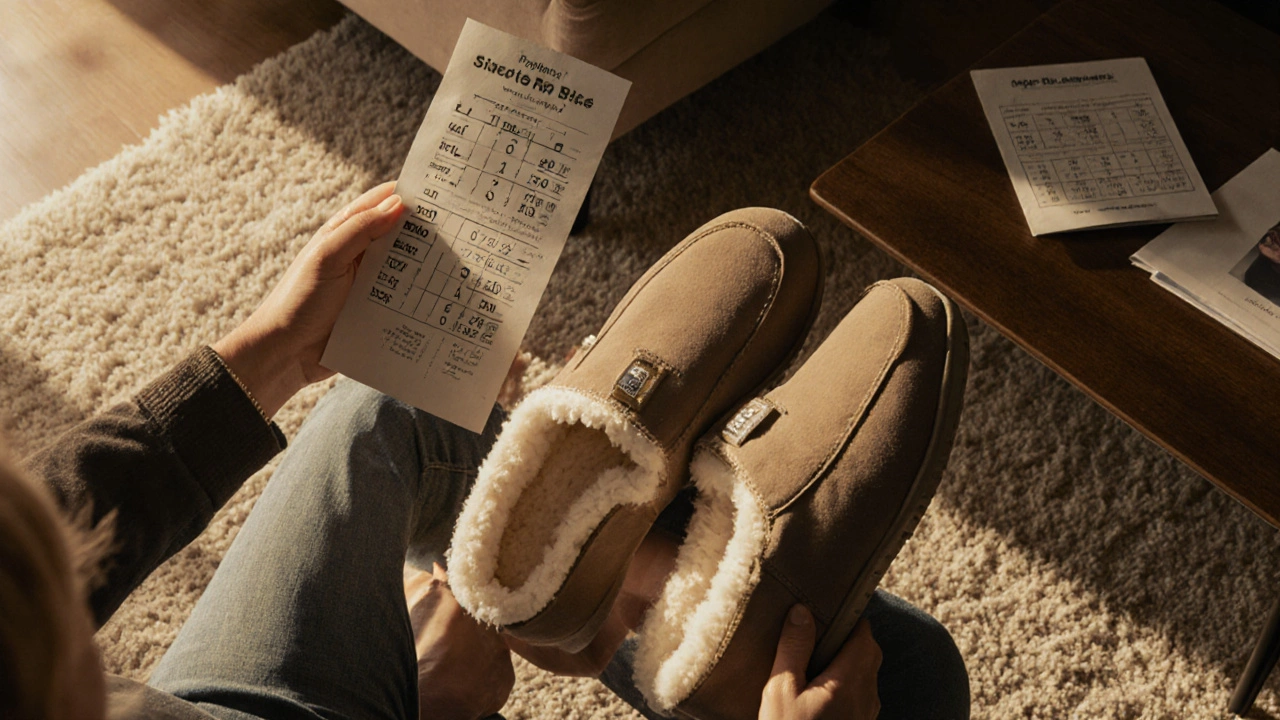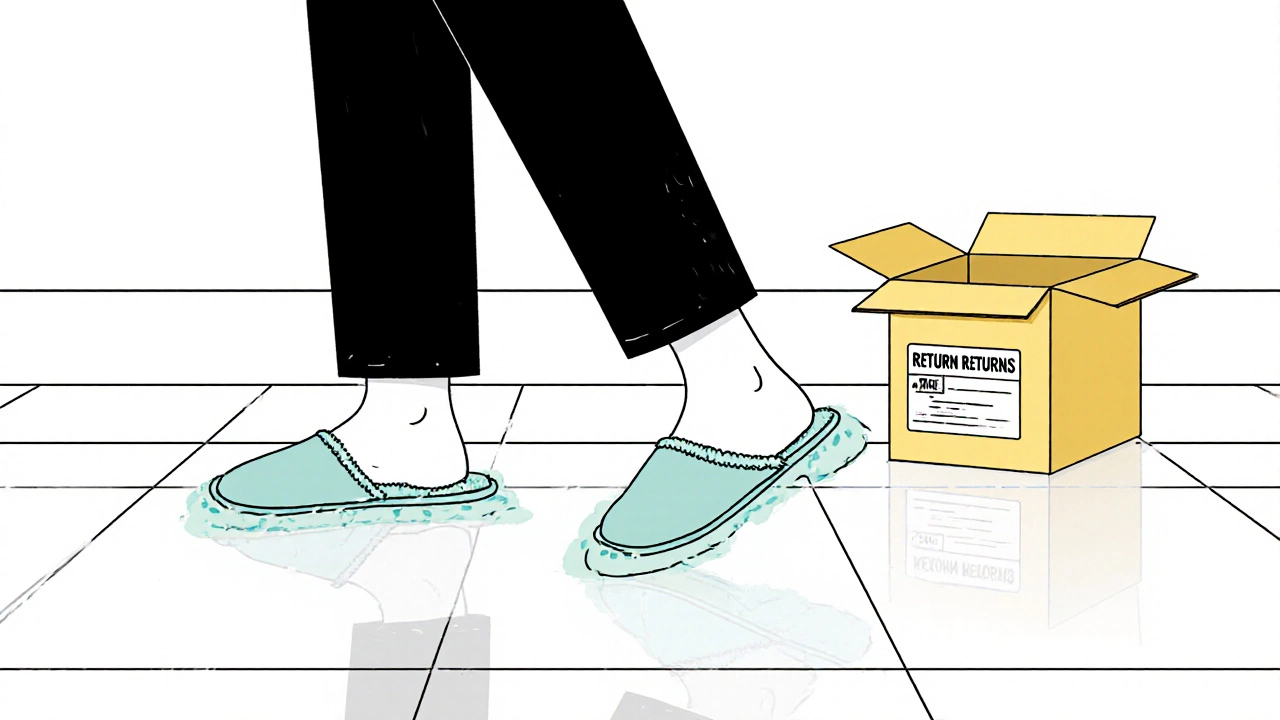Are Slipper Sizes the Same as Shoe Sizes? - The Complete Guide

- Cleo Fairchild
- 26 October 2025
- 0 Comments
When you’re hunting for cozy house footwear, the first thing that pops up is whether slipper sizes are interchangeable with the numbers you already know from your regular shoes. It’s a question that trips up a lot of shoppers, especially when you see different brands listing UK, EU, or US measurements side by side. This guide clears the fog, walks you through the anatomy of a size, shows where the numbers line up (and where they don’t), and gives you a cheat‑sheet you can print or pin to your phone.
Quick Takeaways
- Most brands use the same numeric system for slippers and shoes, but fit can vary because slippers lack laces or straps.
- Always check the brand’s size chart; a UK 8 in slippers might feel tighter than a UK 8 shoe.
- Measure your foot length in centimeters and use a conversion table to avoid guesswork.
- Consider the type of slipper (open‑toe, moccasin, bootie) - each style has its own fit quirks.
- If you’re between sizes, size up for plush fabrics and down for rigid soles.
How Slipper Sizes Are Defined
Just like shoes, most slippers are labeled using the standard UK, EU, or US sizing systems. The number reflects the length of the last (the mold the shoe is built around), not the exact foot length. Because slippers are usually softer and have less structure, the same size can feel looser or tighter depending on material and design.
When a brand lists a size, it’s really saying: “If you wear a UK 9 shoe, this slipper should fit you - unless the construction changes the internal volume.” That nuance is why you’ll see size recommendations like “size up for fleece‑lined slippers.”
Foot Length vs. Size Number
For a rock‑solid fit, start with a foot‑length measurement. Here’s a simple method:
- Stand on a piece of paper and trace the outline of your foot.
- Use a ruler to measure from the heel to the longest toe in centimeters.
- Round up to the nearest whole number; this is your foot length.
Now match that length to a size chart. For example, a foot that measures 25.5 cm usually corresponds to a UK 7, EU 40, or US 8.5 in most manufacturers.
Common Size Conversion Chart
| Foot Length (cm) | UK Size | EU Size | US Men | US Women |
|---|---|---|---|---|
| 23.5 | 5 | 38 | 6.5 | 8 |
| 24.0 | 5.5 | 38.5 | 7 | 8.5 |
| 24.5 | 6 | 39 | 7.5 | 9 |
| 25.0 | 6.5 | 40 | 8 | 9.5 |
| 25.5 | 7 | 40.5 | 8.5 | 10 |
| 26.0 | 7.5 | 41 | 9 | 10.5 |
| 26.5 | 8 | 42 | 9.5 | 11 |
| 27.0 | 8.5 | 42.5 | 10 | 11.5 |
| 27.5 | 9 | 43 | 10.5 | 12 |
| 28.0 | 9.5 | 44 | 11 | 12.5 |
When you compare this table to a specific slipper’s size guide, you’ll see whether the brand follows the standard or adds its own tweak.
Why Slippers Can Feel Different Even at the Same Number
Three main factors shift the fit:
- Material stretch: Knit fabrics and soft leathers will loosen after a few wears. Rigid suede or PVC stays close to the original measurement.
- Design shape: Open‑toe styles often sit lower on the foot, while bootie‑style slippers wrap the ankle and need a little extra room.
- Insole thickness: Some house shoes include a cushioned insole that adds up to 0.5 cm of height, effectively making the interior a half‑size larger.
Because of these variables, many brands advise trying the same size you wear in shoes, then adjusting up or down based on the style you pick.
Step‑by‑Step: Finding Your Perfect Slipper Fit
- Measure your foot length (see the method above).
- Locate the brand’s size chart on the product page.
- Match your foot length to the recommended size.
- Read the fit notes - e.g., “size up for fleece lining”.
- If you’re between sizes, consider the material: up for flexible fabrics, down for stiff soles.
- Check the return policy before you click “buy”. A hassle‑free return lets you test the comfort at home.
Following these steps keeps the guessing game to a minimum and makes sure you’re not stuck with slippers that slide off the moment you stand up.

Special Cases: Kids, Wide Feet, and Orthopedic Slippers
Kids’ sizes are usually marked separately (e.g., “Kids UK 4” vs. “Adult UK 4”). Most manufacturers use a smaller foot‑length range for children, so don’t assume an adult size chart will work.
If you have wide feet, look for brands that list a “wide” option or a “roomy fit” note. A few manufacturers use a “B” width for women and an “E” width for men to indicate a broader last.
Orthopedic or diabetic slippers often come with a roomy toe box and removable insoles. They typically follow the same numeric system but provide extra room for medical devices.
Next Steps & Troubleshooting
After you’ve placed an order, keep these tips handy:
- Try them on with socks. If you plan to wear them barefoot, remove the socks during the fit test.
- Walk around the house. Slip‑on shoes can feel fine standing still but shift when you move.
- Check the heel grip. A snug heel prevents blisters, especially on smooth floors.
- Return quickly if they don’t fit. Most UK retailers give 30 days for a full refund.
If you consistently end up a half‑size off, note the brand’s sizing tendency and adjust future orders accordingly.
Frequently Asked Questions
Do I need to convert my US shoe size to a UK size for slippers?
Yes. Slippers follow the same regional numbering as shoes. A US men’s 10 typically matches a UK 9, but always double‑check the brand’s chart because some use a slightly different scale.
Can I wear the same size in slippers as my sneakers?
Usually, yes. Most brands design slippers to the same numeric standard as sneakers. However, because slippers are less structured, you might need to size up if they’re made of thick fleece or down if they’re rigid leather.
What if I’m between two sizes?
Lean toward the larger size for plush, stretchy fabrics and the smaller size for hard‑sole or board‑like slippers. Many retailers also let you exchange a half‑size without extra cost.
Do children’s slipper sizes match adult sizes?
No. Kids’ sizes run on a separate chart that starts lower (e.g., Kids UK 2 = foot length 13 cm). Always use the children’s sizing guide even if the number looks like an adult size.
Is there a universal “wide” indicator for slippers?
A few brands label a model as “wide” or use a “W” suffix (e.g., UK 8W). Otherwise, check the product description for “roomy fit” or look for customer reviews that mention a generous toe box.
Armed with the right measurements and a solid size chart, you’ll stop guessing and start enjoying slippers that actually stay on your feet. Happy lounging!


